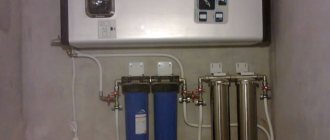The official transfer of the gas water heater is dictated by special provisions of SNiP and in almost all cases is possible only after a number of appropriate approvals. Today, the gas water heater is being replaced by other water heating devices, but sometimes it is more economical and convenient to use a gas water heater, which, if necessary, can be moved to another location.
Scheme of a gas storage water heater.
Moving a speaker in an apartment: requirements and recommendations During the construction of “Stalinist” type houses, the rules were less severe, so according to the technical conditions, speakers were installed, for example, in bathrooms. In accordance with modern rules, gas water heaters cannot be installed in bathrooms. If you want to move a gas water heater from the bathroom, where it was installed when the building was commissioned, for example, to the kitchen, then you will need to coordinate the issue with the organization for the operation of the gas facility and with the design organization.
Classic water heater installation diagram.
Apartment owners often ask the question whether it is possible to move a gas heater from the kitchen or bath to the hallway. In most cases, this is done in order to free up a small part of the space in the room. In accordance with the current rules, it is possible to move a gas water heater into the corridor if a number of requirements are met, namely:
- the corridor room should be wide enough. Moving the speaker will be allowed only if the distance between the equipment (its most protruding parts) and the opposite wall of the room is at least 1 m;
- the height of the room into which the speaker is planned to be moved must be at least 2 m;
- the volume of the room into which the geyser will be transferred must be at least 7.5 m³. When moving or installing two devices - at least 13.5 m³;
- a ventilation duct must be provided in the room where the column is being transferred;
- Do not install a gas water heater above stoves or other sources of open fire;
- When installing a geyser, it must be provided with a separate tap.
These are the main requirements that are contained in the officially approved rules and regulate the procedure for moving a gas water heater. It is prohibited to transfer the column without the appropriate permissions. It is necessary to obtain permits and invite a specialist from the gas company to your home who will carry out all the work.
Independent manipulation of gas equipment is potentially dangerous.
Moving a geyser in a house or apartment: basic rules
Water heater operation diagram.
There are also a number of basic rules for installing gas appliances of any type, which must also be followed when carrying out the transfer. The speaker must be installed on the wall in a vertical position. The equipment must be properly secured and gas and water connections must not be used as a support when mounted on a wall. In the process of transferring a gas water heater, flexible connecting hoses are used.
The easiest way is to coordinate and move gas equipment to a distance of no more than 1.5 m along the same wall where it was installed previously. If you need to move the column to a greater distance from the location provided for by the project, coordination will require much more effort and time. According to the law, this will not be considered a simple transfer, but a replacement of the gas pipeline, that is, the laying of a new gas main. In this case, you will have to go through many instances in an attempt to obtain the coveted certificate stating that the transfer of equipment was carried out in accordance with the law.
When moving, the equipment can be hidden so that it does not spoil the appearance of the room and, at the same time, does not cause complaints from gas services. It is forbidden to completely cover the column - there must be air access from the sides and bottom. In this case, you can order a cabinet without a bottom and side walls, which will fit into the interior of the room.
Moving a gas stove
2. The slab can be moved over a considerable distance - consistent with the development of two projects.
The first project (the project for moving the gas stove will be agreed with JSC Mosgaz, the second project is the redevelopment project + technical conclusion from the Housing Inspectorate (the agreed project of JSC Mosgaz must also be submitted as part of the set of documents submitted for consideration to the housing inspection). In the right picture, the gas stove has been rearranged relative to its original position. And as we see, it appeared in the “red lines" and there is a stamp reflecting illegal redevelopment. Therefore, the answer to this question is unequivocal “yes, rearranging a gas stove is a redevelopment"
Relocation of gas equipment
The counter can be lowered, our neighbors did this, below the table level. And you can also move the boiler, you can place it above the meter, but then you need a competent craftsman to compactly place all the wiring from the boiler in a small area.
PS on the plan is the approximate location of the kitchen unit, if you do not work on converting the gas. At the entrance to the kitchen there is a refrigerator and a sink, then a “peninsula” with a two or three burner stove and a stove (opposite the sink), the rest is a work surface. There is a table + chairs by the window and a sideboard for dishes behind the door to the balcony. Are there any other options for the location of the kitchen unit?
Responsibility for unauthorized connection
Unauthorized connection of a dispenser and other gas-using equipment, cutting into a gas pipeline, damage to a pipeline or technologically related objects - all these and similar actions are punishable. The violator may face not only a fine with compensation for the damage caused, but also admin. or even criminal liability. More on this below.
Stipulated punishment for the offense
Article 7.19 of the Code of Administrative Offenses of the Russian Federation (Code of Administrative Offenses of the Russian Federation) provides for criminal or administrative liability for unauthorized connection of gas devices.
For unauthorized start-up of gas in a private house or apartment, provided that all utilities are connected, but permission to connect has not been issued, you will have to pay from ten to fifteen thousand rubles. Business entities face between 100 and 200 thousand rubles; the exact amount of sanctions will be determined by the court.
If serious consequences arise as a result of an unauthorized connection, criminal liability may be applied to the violator, in accordance with Art . 158 and 109 of the Criminal Code of the Russian Federation.
Such measures of social coercion are assigned to persons if their actions involve one (or more) of the following facts:
- leakage/theft in significant quantities;
- damage to or rendering gas pipelines and in-house facilities, structures, and devices technologically related to them unsuitable for operation;
- there was a danger to the life or health of the residents of the house or specialists of the gas organization.
The government authority may impose a prison sentence of up to 24 months. The subscriber must provide permits for household appliances, an agreement with the gas service, and receipts for payment for gas consumption.
The consumer is obliged to carry out timely cleaning of the components and elements of the geyser. During operation, soot, soot and dust accumulate on the device
An example of calculating additional payment for damage caused
In addition to fines for proven violations, the consumer is also required to cover the costs of the organization supplying the gas. The amount of damage depends on the period: as a rule, additional payment is calculated from the moment of the last inspection, but no more than six months until the illegal action is completely eliminated.
Let's look at an example:
- During a scheduled inspection on March 1, employees of the gas organization did not detect any violation.
- An unscheduled visit on April 31 revealed the fact of unauthorized connection of equipment.
- The violation was corrected on May 14.
The additional payment will be calculated for 74 days . It is in the interests of the subscriber to correct all shortcomings as quickly as possible, since the elimination is considered from the moment of confirmation by the regulatory authorities.
Subsequent calculations take into account the power of gas-using equipment.
For example, for a Bosch Therm 4000 O WR13 water heater, the amount of charges will be as follows:
- according to the technical data sheet of the product, the amount of gas consumed is 2.8 m3/h;
- with round-the-clock operation of the device, the column consumes 4972.8 m3 in 74 billing days;
- Let us assume that the local tariff for the population is set at 8.33 rubles per m3.
Taking into account all the initial data, the additional payment will be 41,423.42 rubles.
To install geysers such as Bosch Therm 4000 O WR13, care should be taken to have a chimney. The technical characteristics require the presence of natural air draft
Obtaining approval for gas pipeline replacement
Whether a transfer is possible or not can only be decided by authorized bodies, that is, the gas service of your city (district). Only a qualified specialist has the right to carry out any dismantling and installation work. Of course, pipes cannot be moved without approval.
Even such a simple step as cutting a pipe by 10 cm must be approved, since all work related to the gas pipeline falls into the risk category
The permit is issued in the following sequence:
- Find out the contact details of the gas service at the place of registration, contact specialists, explain the situation, and consult.
- You draw up an application (using a standard form) that will “launch” the approval process.
- Based on your application, a gas service representative will arrive at your home. The time will be confirmed in advance.
- The specialist performs an inspection, listens to wishes, and answers questions. Often at this stage it is necessary to change plans, since the desired transfer does not meet safety requirements (a preliminary study of the gas pipeline installation standards will eliminate this unpleasant moment).
- Approval of the final transfer scheme, drawing up an estimate. All documents are prepared by the organization providing the services. No work will be carried out without the consent of the property owner.
- If the transfer conditions are met, pay for the service using a receipt and agree on the start time of the work.
The approval procedure usually takes several days; it can drag on for a long period for only one reason: if the property owners and representatives of the gas service have not found a compromise solution.
Any factors that violate the installation standards for gas stoves (boilers, meters, water heaters) may cause refusal to move pipes.
Make a connection
There is a standard procedure for legal connection that both individuals and legal entities should follow.
- First, the required type of gas supply is selected and a professional draft of technical conditions is drawn up. How much does such a service cost? The project and specifications may be different, it depends on the connection object, on those devices that will work on this resource.
- Then an application is submitted to the gas supply organization for connection; it can be considered within a month. Then the applicant must receive an insertion service or a justified refusal.
- After connection, a metering device is installed, it is sealed, and a contract for the supply of the resource is concluded.
Suppliers have the opportunity to check fuel consumption on their territory; sooner or later they will be able to detect unauthorized tapping or connection of additional gas appliances.
Representatives of the gas supply company have the right to check metering devices and gas appliances in a house, apartment, or enterprise; during such checks, unauthorized connections are most often discovered.
How do inspectors act when a violation is detected? They must immediately inform their management about the fact of a legal violation and draw up a report indicating the circumstances of the incident.
The owner of the premises is required to sign such a document. The facility is immediately disconnected from the gas pipeline. Then actions are taken to impose a fine and transfer the case to court.
If a gas water heater is not provided
In a house where the installation of gas equipment, such as a stove, is permitted, the installation of a water heater may be prohibited. This restriction applies to houses with more than 11 floors. No regulatory authority will issue permission to install a water heater in such an apartment, as this is dangerous for the residents.
In addition to the number of floors, redevelopment may be a reason for refusal. Studio apartments are not suitable for installing gas equipment, since the devices must be installed in non-residential premises.
If the kitchen is combined with a living room, this makes the use of gas appliances illegal. These limitations must be taken into account before redevelopment. The same can be applied to apartments where there is no kitchen or is shared.
Image gallery Photos from Gas water heaters with a flow-through principle of operation in apartments are mainly used to prepare hot water; in old two-story buildings they can serve as a unit for maintaining the temperature of the coolant. Installation of a gas water heater is allowed in houses no higher than five floors that are not connected to a centralized hot water system. In high-rise buildings connected to a central hot water supply system, gas equipment is not installed. Small private houses with an area of no more than 150 m² are also equipped with gas flow heaters. The instantaneous water heater processes the water passing through it in the amount necessary for immediate use. The gas water heater is not intended to form a supply of hot water. and maintaining its temperature, which explains its small, easy-to-use dimensions. Gas instantaneous water heaters for apartments are available in wall-mounted versions. They should be located so that free access is guaranteed for servicing the water heater and its connection points. Installation of more than two gas water heaters in one room is not allowed. The use of both flow and storage equipment is allowed in quantities of 1 piece each. An exception is multi-level apartments. Gas heating equipment is allowed to be installed only in private apartments and houses; placement in dormitories, gyms, hotels, etc. is prohibited. where different people can be used Flow-through gas water heater Productive small-sized device Operation of a water heater in private homes Advantages of a gas water heater Compact dimensions of flow-through equipment Features of heater placement Two gas water heaters in one room Installation of the heater only in residential buildings and apartments
If the house does not fall under these restrictions, then it is necessary to collect a package of documents to register the device.
The procedure is as follows:
- Write an application to the gas distribution company.
- Get a plan from the BTI or Rosreestr.
- Provide an extract from Rosreestr confirming ownership.
- Contact a specialized organization to draw up a project.
- Find certified specialists from an organization that has access to gas work.
After this, specialists will make an insert into the gas pipe, connect the device and put the water heater into operation.
It is highly not recommended to install a geyser yourself, bypassing the legal order. These actions not only lead to fines, but also put people's lives at risk.
What it is
You can connect to the gas pipeline only with the permission of the organization that supplies gas to the population and enterprises.
As a rule, such an organization owns the gas system, equipment, and gas distribution complexes. It works in a certain territory, is engaged in laying gas pipelines and connecting to them.
You cannot independently, without the approval of this authority, connect to the gas supply system and use the natural resource.
But they do not think about how serious the liability for illegal tapping into a gas pipeline can be. After all, this is not only a fine and disconnection from the network, the court may also impose imprisonment for several years.
You won’t be able to save money; you will need to pay a fine, money for damage to the gas system, and there will be additional costs for a legal connection. And for the period of gas use, suppliers will calculate the amount taking into account round-the-clock consumption:
- Owners of private houses make an independent connection to the network if there is already a branch from the gas pipeline to the house. They commit not only gas theft, but also dangerous interference in the operation of the network.
- Apartment owners who are forcibly disconnected from the gas pipeline for non-payment of the supplied resource or for operating faulty equipment and metering devices also violate the law.
- The law also considers it a violation to independently install metering devices and pay the supplier according to its indicators. The meter must be sealed by a representative of the gas company. An indicator verification report is drawn up. And only then will the IPU indicators be taken into account and used to draw up a payment order.
Actions of citizens to connect to the network without permission and an agreement with the supplier company, independently connecting gas appliances will entail more costs and problems than doing this legally.
Stages of replacing a geyser
You can find out complete information on the selection, operation and maintenance of gas water heaters (instantaneous water heaters) from all manufacturers if you go.
In addition to specific information on the site, you can also study specific problems from other people on this topic who have already purchased a gas water heater or instantaneous water heater and thus avoid them. You will find a regularly updated list of such problems and their solutions.
Dismantling the column.
You can do this step yourself, as it is not prohibited by documents. Here you can save from 700 to 1000 rubles, all depending on the region. Here are several price options: in Saratov it is 890 rubles, Kazan 710 rubles, St. Petersburg 950 rubles, Kaliningrad 820 rubles.
Stages:
- Close the gas supply valve.
- Disconnect the gas tube from the column; for this you will need an adjustable wrench. If the tube is in good condition and was not damaged during dismantling, it can be reused.
- Disconnect the boiler from the pipe from which cold water is supplied. When turned off, water may flow out; you need to prepare a container for it.
- Next, disconnect the chimney.
- When removing the column, it is necessary to dismantle the device casing, then unscrew the fasteners.
After completing these activities, contact a specialist for further work.
Next, we will look at the installation in detail.
By the way! Did you know that a geyser from any manufacturer can explode at any minute - » «.
When moving a speaker, you must meet the room requirements described above. The easiest way to coordinate a transfer is up to 1.3 meters. If the transfer is greater, this is already a replacement of the main line. In such a case, you will have to go through many government agencies to obtain documentation. It will be necessary to change the communications plan.
The following steps must be followed:
- Contact the fire department and obtain a report on the condition of the chimney system.
- Get a re-coordinated project from the city gas service, or you can contact a private certified organization.
- For a council house, it is necessary to obtain permission for redevelopment from the city administration.
- Have on hand documents confirming ownership of the apartment.
- Technical data sheet for the boiler.
With the collected package of documents, contact Gorgaz,
Company employees will carry out a number of activities to connect and install it to all necessary systems. After completion of the work, the service employee will configure and launch. Under no circumstances should you do this yourself, as an accident may occur that will entail serious consequences. He must check the tightness of all connections and joints using a foam solution. If there are no bubbles, it means the installation was done correctly. Next, he will seal the meter and issue a commissioning certificate. Upon completion of all work, you will need to submit information to the BTI about changes in the location of the equipment.
The cost will be about 30 thousand rubles. Kaliningrad region, Kazan about 27 thousand rubles, Saratov 28 thousand rubles, St. Petersburg 32 thousand rubles. The price depends on the region of the country, local fees for documentation.
Gas fine
Gasification of a private home, as well as the installation of various equipment powered by gas, can be carried out exclusively on the basis of special regulations. The main document for this is Government Decree PF No. 549, which describes the procedure for gas supply to meet the needs of citizens.
The fine for breaking the gas seal on the meter or for damaging it in other ways varies from 2 to 15 thousand rubles. It depends on whether the process is done intentionally, as well as on when the violation is detected and whether it led to a decrease in the performance of the device.
Preparation
Before replacing or installing a new geyser, the site is prepared.
If replacement is intended, the old column is dismantled. Be sure to check the quality of closing the valve on the gas pipe to avoid gas leakage. All valves on the water pipes are closed.
The pipes from the column and the flexible gas hose are disconnected, and the chimney is dismantled. The column is carefully removed. Often, this requires removing the front panel and then unscrewing the fasteners.
The wall under the column most likely requires cosmetic repairs. Old fasteners are removed, and the holes left behind are sealed with mortar.
For final installation, the wall is leveled. A special adapter is attached to the chimney opening for connecting a flexible corrugated pipe 110-120 mm.
- Impact drill or hammer drill and a set of 8-10 mm drills;
- A set of fastenings (self-tapping screws with a hook, anchors). The size and type of fastenings are determined in accordance with the requirements of the speaker manufacturer;
- Bubble or laser level.
To access the speaker mounts, remove the front panel. According to the markings of the geyser fastenings, mark on the wall places for installing hooks or anchors. Be sure to check the position of the marks according to the level. Using a drill or hammer drill, two (four) holes are drilled into which dowels or anchors are inserted.
Most modern gas instantaneous water heaters have a mounting plate. It is this that is attached to the wall, and then the column is attached to it using latches. The task in this case is simplified; it is enough to attach the plate to the wall, level it and mark the places of fastenings along it.
Drill one hole at the required height and secure the plate, then, aligning it level, drill the remaining holes directly through the holes for the remaining fasteners and complete the installation.
All that remains is to fix the column in its place. It is too early to reattach the front panel, so carefully set it aside so as not to scratch or damage it.
The chimney for a column with an atmospheric burner can be a corrugated steel pipe of 110-120 mm, laid from the outlet of the column to the entrance of the common chimney. The pipe should fit tightly to the sockets; if this is not the case, then additionally crimp it with a metal clamp.
For columns with a closed combustion chamber, orient the outlet inside the column in the desired direction and lay a coaxial chimney to the nearest wall in contact with the street. The maximum permissible length is indicated in the instructions.
The wall is passed through with a hammer drill, after which the chimney is inserted. The gap between the pipe and the wall is foamed or filled with non-flammable insulation, such as basalt wool.
What is considered an illegal connection?
Gas is supplied to residential buildings using a complex system of gas pipelines, gas distribution stations and intra-house gas pipelines. Any attempt to connect gas-consuming equipment to the gas pipeline independently is called an unauthorized connection. Gas equipment includes:
- boiler;
- column;
- kitchen stove;
- hob;
- oven.
In-house gas equipment includes not only appliances, but also gas lines and taps that regulate the supply. That is, if an energy consumer has unauthorizedly installed additional gas pipes, this is also punishable by law. Unaccounted energy consumption is also considered an offence.
Reference. If the equipment was connected correctly, and then the user unauthorizedly removed the metering devices and reconnected them after the meter or deliberately changed their readings (using neodymium magnets, for example), he will be subject to administrative penalties.
According to Decree of the Government of the Russian Federation dated May 14, 2013 N 410, any manipulations with gas equipment (repair, replacement, shutdown) must be performed exclusively by gas service workers.
Basic installation safety rules
It is required to follow many rules and features when installing a gas water heater and water heater. Otherwise, owners may be fined large sums.
It is important to equip the chimney and ventilation system. The efficiency of moving air flows, as well as the timely removal of smoke from the room, depends on this
It is strictly forbidden to install the unit above a sink, refrigerator, or gas stove.
The ventilation hole must be of such a size that air can easily pass in the required quantities without clogging the main components of the system. If you forget about this requirement, then over time a large amount of toxic substances can lead to emergency situations, as well as poisoning of all residents in the house. The risk of gaseous waste explosion increases. This is especially true at night, when people are physically unable to detect a gas leak in the house.
Access to the gas water heater should be as free as possible. This will ensure quality service and the ability to inspect the device if necessary.
In order for the gas water heater to function normally, it is necessary to arrange a passage to the chimney. It can be connected to a common main line or mounted independently. During installation, it should be taken into account that the number of bends for normal air flow should not exceed the established norm. Otherwise, difficulties arise with transporting air flows to the outlet. The length of the chimney is established by law. Otherwise, a chimney pipe will be required to ensure normal levels of air circulation.
Do not mount the device too low or high.
The installation location of the gas outlet pipe is located in such a way as to provide optimal outlet for the column. For installation, you should use pipes that are made of substances that are resistant to combustion processes. Increased risk of fire. The best option would be pipes that have a low degree of thermal conductivity.
The pipe is usually connected in a vertical position. The length of this section is at least fifty centimeters for normal operation of the installation. In some cases, it is permitted to use corrugated pipelines. There should not be any sagging or unevenness.
It is advisable that the boiler be at eye level or at least within sight.
If it is not possible to install a chimney, you need to take care of another method of removing gases. For example, you can install a powerful hood that has sufficient draft to remove gas outside. It is necessary to arrange the system in accordance with the design documentation.
Many owners of houses and apartments have a natural question whether it is possible to cover the gas water heater with a cabinet. It can be done
At the same time, it is important to follow certain rules for placing the dispenser so that there are no problems with the gas service
It is better not to decorate the walls near the speaker with wallpaper and plastic panels. The surface on which installation is to be carried out must be covered with non-flammable materials.
The water heater must not be connected to a load-bearing wall. You also cannot install the column using this method. This can be explained by the fact that in the event of an explosion the entire house could collapse. To clarify this issue, you should contact specialists. They will conduct research of the area, which will help determine the method and location of installation of the structure.
It is also necessary to follow certain rules for placing the system. Treatment of the area in the stopping area must be made from materials that are resistant to combustion. This will help prevent the possibility of a fire. The structure cannot be installed on wooden surfaces. This will require pre-processing.
In the room where the heater operates, you should not overdo it with waterproofing and insulation of windows.
To achieve high safety of the geyser, you should not install it above other gas appliances. It is recommended to keep your distance. It is necessary to carefully check the sealing of each channel and install the pipes in accordance with legal regulations.
Requirements for the room where the column is installed
They are set out in the following standards SNiP 42-01-2002 and SP 42-101-2003
Key list of requirements:
- The width of the room must be sufficient. In
fact, the distance between the device and the wall is no less than 0.9 m. - The ceiling height should be 2.25 m.
- The room must have a volume of at least 7.6 m².
- First of all, it is equipped with a ventilation window; its area is calculated using the formula.
- There is a hole for ventilation.
- Installation above direct fire sources is not allowed.
- The wall surface is plastered.
- The presence of a front door with a width of at least 0.7 m.
- The place should be fairly lit.
- First of all, the presence of a cold water supply.
- The room must have a chimney with a diameter of 125 mm.
- Installation of the boiler only vertically.
In accordance with the developed requirements of SNiP 41-01-2003, columns must be installed meeting the following conditions:
- When installing equipment, the presence of flammable objects is prohibited.
- on the surface of a wall made of highly flammable materials, insulated with non-combustible materials.
The insulation must exceed the dimensions of the equipment body by 50 cm at the top and by 15 cm on the side.
Replacement procedure
Here we come directly to the process. What is needed to change a gas water heater? You are required to carefully prepare the room in accordance with all standards, check the functionality of the ventilation and chimney systems, and then call specialists to install and connect the equipment. They will handle everything else themselves, all you have to do is sign an act of acceptance of the work.
It is also highly recommended to install an air composition analyzer in the room where the gas water heater will be located. The device is very simple to install and at the same time performs an extremely important function. If the propane content in the air increases, the analyzer will immediately begin to signal. This way, you won't miss a leak even if you're asleep. A timely and quick reaction in such situations is an almost guaranteed favorable outcome. Therefore, do not neglect installing such a small but very useful thing. Good luck!
Recommendations for choosing a new speaker
The main parameters when choosing a geyser are power and performance. They should be given priority attention if you do not plan to redo the project when installing the column in its original place. The power of the new device should not exceed that specified in the project.
For a family of 1 - 2 people, a dispenser capacity of 10 liters per minute is usually sufficient, which corresponds to a power of 17 - 18 kW. If replacing the device is associated with the desire to use two points of water consumption at the same time, for example, a sink and a shower, then the productivity of the gas heater should be at least 13 l/min.
For three points, including filling the bathtub, you need to focus on 15 l/min. Provided there is sufficient pressure in the water supply.
When choosing a new water heater, it is important to decide whether the previous power of the water heater is enough for the needs of the family or whether you will need to purchase a more efficient device, which will entail the need to order a new project
Many models of geysers have a flame modulation function. Its purpose is to maintain a constant temperature (with an accuracy of 1 - 3 degrees) at the outlet of the device, regardless of water consumption. Choosing such a model will allow you not to worry about adjusting the temperature when several family members turn on hot water at the same time.
Before installing the column, you need to check the condition of the chimney, pipelines, taps, and determine which elements will require updating.
Column layout rules
The water heater cannot be located on a load-bearing wall of the building. This is directly prohibited by the requirements for the installation of geysers. In the event of an explosion, this may result in damage to the building or its partial destruction.
To clarify the possibility of installing the device, you need to take information from the cadastral passport of the apartment and the general plan of the house. This information can be clarified by calling specialists.
There are requirements for the space from the column itself to the opposite wall. The distance should not be less than one meter. This is necessary for free access to the device for its maintenance and inspection. It is also forbidden to install gas supply pipes into the walls.
This makes it difficult to inspect communications and find gas leaks in the apartment. If this violation is detected, an order to eliminate it will be issued and information will be provided on how to correctly install the gas water heater and where to contact.
The column must be located at a distance of more than 10 cm from the wall. It is not allowed to install a gas water heater on a wooden wall without prior preparation. A steel plate must be installed at the installation site, equal to or larger in area than the back wall of the device.
It is not allowed to install a column above a gas stove. These devices must be at least 1 meter apart from each other. Also, you cannot use the hood for a gas stove as a exhaust outlet for combustion products. You cannot use one chimney for the hood and gas water heater. This is expressly prohibited by safety regulations.
Image galleryPhoto from When choosing a place to install a speaker, it is necessary to observe the standard distances that ensure safe operation. There must be at least 30 cm between the sink and gas equipment. Between the gas stove and instantaneous water heater there must be a distance of at least 10 cm. In front of the gas water heater, a shut-off valve must be installed on the gas supply pipe, which is necessary to shut off the line. Between the mixer and the outlet of heated water from the gas It is recommended to leave a distance of 1 m between the columns, which is required for normal operation of the automation Standard distance from the sink Distance between the stove and the gas column Shut-off valves on the gas supply pipe Specifics of the location of the mixer
Kitchen design with a column: possible options for successful placement
On the one hand, owners of gas or electric water heaters can be considered lucky.
They do not depend on centralized hot water supplies and have the opportunity to use water at the desired temperature all year round.
On the other hand, the design of a kitchen with a speaker installed in it is not always aesthetically pleasing, and in small rooms, for which Khrushchev buildings are famous, the units take up extra space and simply get in the way.
Options for placing speakers in the interior
For a kitchen with a large area, there are practically no problems with determining the location of the speaker. The equipment is installed either directly in front of the water collection point, or on that section of the wall where it is least noticeable.
For a small kitchen in a Khrushchev-era building, options for successful placement of a water heater come down to four possible solutions in which it can be used:
- move to another room, for example, to the bathroom, which the device also serves;
- hide in a furniture set;
- put on display, having previously decorated;
- fit harmoniously into a row of wall cabinets.
Each of the proposed options has the right to exist. And only the owner of the apartment can decide which one to choose, after consulting with specialists. This will require thoughtful design, as well as identification of possible material costs and risks.
Moving the speaker from the kitchen to the bathroom
Khrushchev apartments are famous not only for their tiny kitchens, but also for their far from perfect bathrooms. But if the bathroom in the apartment is combined with a toilet, then you can try to organize a “corner” with a speaker in it. For safety reasons, the location should be chosen so that water cannot enter the housing.
The decisive point is the technical side of the issue regarding the transfer of a gas pipe with a water heater from the kitchen to another room. The fact is that there are certain requirements for the safe operation of equipment, providing for:
- obtaining special permission from gas services;
- organization of ventilation;
- ensuring free access to devices.
For electrical speakers, you will need to perform a separate electrical wiring after consultation and approval of its diagram with specialists.
In most cases, these conditions are difficult to achieve, so owners try to resort to the option of moving water heaters in rare cases. An aesthetic kitchen design with a modern speaker installed instead of an old and bulky device will be much simpler and cheaper.
Speaker in the closet
Manufacturers of water heating systems fully allow the installation of equipment behind furniture facades of wall cabinets. Kitchen design only benefits from this. But in this case, a number of conditions must be met to ensure fire safety and the safety of furniture from destruction.
First of all, the distance between the inner walls of the cabinet in which the column is supposed to be placed must be wider than the body of the water heater by more than ten centimeters.
This helps ensure good natural ventilation and does not interfere with the installation of non-combustible insulation on the side walls of furniture, preventing them from burning, swelling and deterioration.
note
Such a cabinet is made to order, without a back wall, with multiple holes drilled at the bottom for communications, and at the top for a ventilation pipe.
This option is ideal for a kitchen in a Khrushchev-era building with a column installed in the corner. The facade, in this case, creates the illusion of a corner cabinet. Moreover, there is no need to change old furniture. Its design can be refreshed and made more original, for example, by using a lattice door.
Column exposed
The cases of modern speaker models are made not only white, but also black, steel, and also colored. The design of the front panel can be made using multifaceted patterns, paintings or ornaments. For a kitchen in a Khrushchev-era building, such a water heater will be a real “discovery”, although buying it will not be so easy and not too cheap.
Craftsmen suggest decorating the column yourself. You can apply small patterns to the body using stencils and heat-resistant metal paint, or paint it with special enamels in contrasting shades. This will help highlight the water heater from the general background, focusing attention on it. There are many options, the main thing is imagination.
Conclusions and useful video on the topic
These videos show the provisions described in the article in practice. This video shows a kitchen design option in which gas pipes are hidden using kitchen furniture. Placing the gas hose as shown in the video is prohibited:
This video shows how to move a gas pipe in the kitchen by specialists. Here everything is done in accordance with the requirements:
This video, shot by one of the TV channels, talks about the reasons (why it’s not possible) and the consequences of illegally moving a gas stove:
Based on everything said above, we can conclude that it is possible to move the slabs within the kitchen if the length of the hose used for connection allows it to remain in a loose state. Moreover, such an operation is not even considered a redevelopment. Also, the gas stove can be moved to another room, subject to a number of conditions and with the mandatory approval of the redevelopment by the relevant government agencies.
Would you like to share your experience of moving a gas stove? Or do you still have questions that we did not cover in this material? Ask them to our experts and site visitors, write your comments and other interesting information that may be useful to other users.
Relocation of the boiler from a regulatory point of view
Internal gasification project is a document containing detailed schematic information on the floor plan of a residential building with identification of technical points for the location of gas-using equipment on a scale of 1:100.
That is, moving a gas-fired heat generator to another location is a violation of the design documentation and requires changes to it.
Let's figure out whether it is possible to move a gas boiler to another place? And if it is possible, then by what regulatory documents is this approved and where is it recorded?
The “housing issue” regarding the transfer of a gas boiler and other equipment in an apartment is determined by a number of articles of the Housing Code (Housing Code) numbered 25-29. And this process is called reorganization. The regulatory collection contains detailed information on the approval of the procedure, possible refusal and its protest, the consequences of unauthorized transfer, and so on.
The specified articles of the code of housing standards apply specifically to the premises of multi-apartment buildings, i.e. regulate measures and standards for the transfer of gas pipes, meters, boilers within apartments. However, this does not mean that no rules apply to private houses.
According to the resolution of the State Construction Committee of the Russian Federation dated September 27, 2003, clause 1.7., only after obtaining permission is it possible to carry out the refurbishment of premises for any purpose. In this case, the transfer of gas appliances falls under this definition.
Moreover, independent installation and replacement of a gas heat generator is not prohibited, but its admission into operation and connection must be carried out by employees of a gas supply company with the appropriate license.
In addition, you will have to coordinate the transfer of gas distribution, metering devices and other gas equipment at home. For uncoordinated actions, you may be required to return all gas equipment to its original location. In this case, you will have to pay considerable fines for each of the moved devices, even after reinstallation.
Administrative liability for unauthorized transfer of a boiler is determined according to the type and severity of the violation. There are penalties, obligations to return devices to their original location, and even shutdown of gas supply. It is almost impossible to challenge the sanctions in court, because you will in fact violate the requirements of the housing code.
The punishment is justified, because unprofessional installation of equipment, as well as changes in the design, are a gross disregard of fire safety requirements, a threat to the life and health of people living in the building, and a violation of the gas supply engineering scheme.











